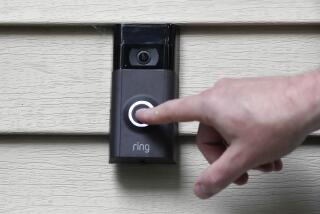Bracelet Designed to Deter Stalkers of Women : Crime: Colorado county fits electronic ankle devices on first offenders, and victims of harassment carry receivers that sound alarm when they are approached.
- Share via
LITTLETON, Colo. — With domestic violence increasing, authorities are experimenting with an electronic system that sets off an alarm when a stalker approaches his victim.
Under a three-month program adopted by Arapahoe County, a known offender wears an electronic ankle bracelet that triggers an alarm if he goes near the person he is accused of harassing.
The alarm sounds on a receiver near the victim and a simultaneous signal goes to a communication center, which alerts police. The victim has a “panic button” on the receiver if the abuser disconnects the bracelet before coming near her.
The first offender was fitted with a bracelet this week, said Dist. Atty. Robert Gallagher.
“We are in the midst of a revolution, and the revolution is rapid intervention,” said Michael Lindsey, co-founder of Third Path, a program for male batterers.
Arapahoe County is the first jurisdiction to try such a device, according to the manufacturer, Bodyguard Technologies of Boulder. Eventually, dozens of abusers may wear the bracelets.
The program is limited to domestic violence situations. Offenders are given the option both at pretrial hearings and upon conviction of wearing the bracelet, going to jail or posting bond.
An increase in stalking incidents, with often tragic consequences, has spurred authorities to try new approaches.
Similar bracelets have been widely used for monitoring convicts sentenced to home detention, but never as warning devices for potential victims, Arapahoe County officials said.
Police and battered women’s shelters in Boston are supplying “panic buttons” to domestic abuse victims so they can summon help with an electronic signal, but no bracelets are involved. Similar buttons, which work like medical alert systems, have been distributed in Tampa, Fla., and Cambridge, Mass.
In Colorado, the Legislature this year approved a bill to discourage stalkers after a woman was gunned down in Ft. Collins on the steps of a police station by her ex-boyfriend and another woman was killed on a downtown Denver street by her estranged husband, who then committed suicide.
Anti-stalking bills also have been enacted in other states.
Activists hail Arapahoe County’s fledgling bracelet program as a behavior modification tool, but say it will not be foolproof.
“It’s a very specific program aimed at breaking an obsession,” said Lindsey. “The bad news is, at this time nobody can stop a first-degree murder case.”
Officials went to work on the project after the county’s domestic violence rate skyrocketed in the past two years. The Sheriff’s Department handled 372 cases in 1991 and 634 cases during the first seven months of 1992.
Barbara Shaw, executive director of Project Safeguard, which aids battered women, said the best part of the program is that it is community-based and sets off a coordinated response.
“We were really afraid this would be another widget that got out there on the market and people would use it however they wanted to use it,” she said. “It had to be part of a larger intervention.”
Working with Lindsey, Shaw, and court and sheriff’s officials, Bodyguard Technologies put together a program that called for counseling of the victim and the perpetrator, said Pat Patterson, a company spokeswoman.
The victim also receives training in how to handle the offender when he comes near, knowing the police are on the way, Lindsey said. Although Lindsey said he can’t divulge exactly what tactics are taught, he said “it’s how to barricade, how to buy time.”
Offenders also will undergo treatment while wearing the bracelet--a “stabilizing” program to discourage obsessive behavior, followed by counseling.
The bracelet system should improve police response time when a 911 call is received, Lindsey said.
The bracelet can be removed with bolt cutters, officials said, but a tamper detection system is activated.
Officials would not say how close an offender can come to the victim before the alarm is triggered.










